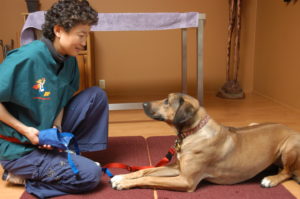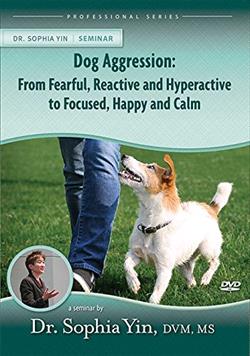
As Dog Bite Prevention Week is being recognized across the United States, the Center for Disease Control reports that 4.7 million Americans are bitten by dogs every year. Nearly 20% of those bitten seek medical attention and approximately 1000 victims per day require a visit to the hospital emergency room. Not surprisingly, one group at risk is animal care professionals—veterinarians, groomers, shelter workers and people who work or volunteer in the animal care field.
A majority of bites could be prevented if animal care professionals recognized the warning signs and took a more sensitive and deliberate approach to handling. After spending over a year studying what makes some handlers more effective than others while developing a textbook and DVD for pet care professionals called “Low Stress Handling, Restraint, and Behavior Modification of Dogs and Cats,” I have identified a set of low stress techniques that can help both professionals and pet owners prevent bites.
Here are seven tips for preventing dog bites:
- Since most dog aggression is actually due to fear or anxiety, it’s essential for animal healthcare professionals to recognize the signs of fear and anxiety. The more blatant signs of fear are that the dog backs away from you, cowers, or puts its tail between its legs. But dogs exhibit more subtle signs too, such as averting their gaze, yawning, licking their lips, moving in slow motion, or acting sleepy when they should be wide awake. Animal care workers should also be on alert for a slight lifting of the lip or a sudden tense, frozen posture. When a dog exhibiting these warning signs is pressured it is likely to result in a bite.
- Set up a safe, comfortable environment. Many dogs are afraid of unfamiliar dogs and people and are uncomfortable in new environments. As a result, it’s essential to make the environment as calm and comfortable as possible. For instance, veterinary hospital waiting rooms should have enough space or room dividers so that dogs aren’t face-to-face with people or other dogs they fear. Once their fear and arousal levels rise, they’ll be more likely to bite as the visit progresses.
For more tips, check out Dr. Yin’s DVD on Dog Aggression available here in the Cattledog Publishing store.
- Make a good first impression by approaching the dog correctly. A head-on approach and an outstretched arm can force a fearful dog to feel like it has to defend itself. A more appropriate approach is to stand or crouch sideways, avert your gaze, and let the dog make first contact. Speaking in a happy voice and tossing multiple small treats can also change the dog’s perception of what you’re up to.
- Avoid hugging or placing your face into the face of an unfamiliar dog. While some dogs may tolerate being hugged, few dogs actually enjoy it. Even a friendly dog may bite when an unfamiliar person invades its personal space in this frightening manner.
- When possible, avoid holding animals down for handling procedures they dislike. Instead, take the time to train the pet to enjoy it. Forcibly restraining dogs for procedures such as a toenail trim can make the dog more fearful or reactive each time you try, and the dog can become more fearful or aggressive towards unfamiliar people. Dogs can be trained to enjoy regular handling procedures such as pilling, grooming, and toenail trims – often in a very short amount of time, such as 5 minutes. The more skilled the handler’s technique at pairing positive experiences with the previously unsavory handling and the fewer bad experiences the dog has had, the quicker the good behavior can be trained. See an example of training a dog to enjoy a toenail trim (http://www.youtube.com/watch?v=WWZUcLfHXLE).
- When restraining or repositioning an animal make sure you’re supporting the animal well so it feels secure. If you’re placing pressure in the wrong areas or the animal does not feel secure, your handling can actually make the animal struggle and become aggressive.
- Control the dog’s movement. Avoid chasing the dog or letting it pace as these will cause the dog to become more anxious, excited, or aroused and consequently more likely to bite. Instead, calmly control movement by keeping an appropriate and consistent leash length. The leash should be long enough so there’s no pressure on the dog when it’s stationary but short enough to keep the dog from pacing.
Dr. Sophia Yin’s Biography
Dr. Yin was a veterinarian and applied animal behaviorist, an executive board member of the American Veterinary Society of Animal Behavior, a past animal behavior lecturer in the Animal Science Department at the University of California, Davis, and an award-winning writer. She lectured internationally on animal behavior and developed low stress handling workshops for veterinary staff, students and animal care professionals across the country (Read article on a handling workshop at University of Wisconsin). She passed away in 2014.



